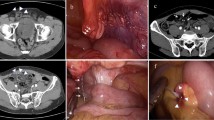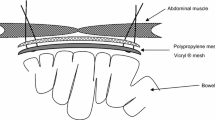Abstract
Introduction
Transabdominal preperitoneal hernioplasty (TAPP) is a common procedure for groin hernia repair in adults. The peritoneal closure after mesh placement can be performed in various ways. In any case, thorough closure is recommended to avoid mesh exposure to the viscera with the risk of adhesions and bowel incarceration into peritoneal defects. Postoperative intestinal obstructions can mainly occur due to adhesions or bowel herniation through peritoneal defects into the dissected preperitoneal space. Incarcerations can also occur as a consequence of trocar site herniation.
Results and conclusion
Recently barbed self-anchoring knotless suturing devices are frequently used for peritoneal closure. The correct handling of such sutures is crucial to avoid potential complications. Despite of accurate management, bowel adherence and injuries or volvulus can occur.
Methods
We present an unusual case of a postoperative small bowel obstruction owing to strained adhesions and ingrowth between a small bowel segment and a polyglyconate unidirectional self-anchoring barbed suture device. Medline and PudMed databases were searched using the below-mentioned keywords and the literature on efficacy and safety of barbed sutures for peritoneal closure is reviewed as well as the usage of such devices in other fields of surgery.

Similar content being viewed by others
References
Mahon D, Decadt B, Rhodes M (2003) Prospective randomized trial of laparoscopic (transabdominal preperitoneal) vs open (mesh) repair for bilateral and recurrent inguinal hernia. Surg Endosc 17(9):1386–1390
McKay R (2008) Preperitoneal herniation and bowel obstruction post laparoscopic inguinal hernia repair: case report and review of the literature. Hernia 12(5):535–537
Bittner R, Arregui ME, Bisgaard T, Dudai M, Ferzli GS, Fitzgibbons RJ, Fortelny RH, Klinge U, Kockerling F, Kuhry E, Kukleta J, Lomanto D, Misra MC, Montgomery A, Morales-Conde S, Reinpold W, Rosenberg J, Sauerland S, Schug-Pass C, Singh K, Timoney M, Weyhe D, Chowbey P (2011) Guidelines for laparoscopic (TAPP) and endoscopic (TEP) treatment of inguinal hernia [International Endohernia Society (IEHS)]. Surg Endosc 25(9):2773–2843
Facy O, De Blasi V, Goergen M, Arru L, De Magistris L, Azagra JS (2013) Laparoscopic gastrointestinal anastomoses using knotless barbed sutures are safe and reproducible: a single-center experience with 201 patients. Surg Endosc 27(10):3841–3845
Takayama S, Nakai N, Shiozaki M, Ogawa R, Sakamoto M, Takeyama H (2012) Use of barbed suture for peritoneal closure in transabdominal preperitoneal hernia repair. World J Gastrointest Surg 4(7):177–179
Miserez M, Alexandre JH, Campanelli G, Corcione F, Cuccurullo D, Pascual MH, Hoeferlin A, Kingsnorth AN, Mandala V, Palot JP, Schumpelick V, Simmermacher RK, Stoppa R, Flament JB (2008) The European hernia society groin hernia classification: simple and easy to remember. Hernia 11(2):113–116
Tolver MA, Rosenberg J, Juul P, Bisgaard T (2013) Randomized clinical trial of fibrin glue versus tacked fixation in laparoscopic groin hernia repair. Surg Endosc 27(8):2727–2733
Lovisetto F, Zonta S, Rota E, Mazzilli M, Bardone M, Bottero L, Faillace G, Longoni M (2007) Use of human fibrin glue (Tissucol) versus staples for mesh fixation in laparoscopic transabdominal preperitoneal hernioplasty: a prospective, randomized study. Ann Surg 245(2):222–231
Bittner R, Leibl BJ, Jäger C, Kraft B, Ulrich M, Schwarz J (2006) TAPP—Stuttgart technique and result of a large single center series. J Minim Access Surg 2(3):155–159
Shatari T, Nozawa K, Mieno K, Kodaira S (1998) A new method of peritoneal closure following laparoscopic herniorrhaphy. Surg Today 28(8):866–867
Jones DB, Callery MP, Soper NJ (1996) Strangulated incisional hernia at trocar site. Surg Laparosc Endosc 6(4):152–154
Duran JJ, May JM, Msika S, Gaschard D, Domergue J, Gainant A, Fingerhut A (2000) Prevalence and mechanisms of small intestinal obstruction following laparoscopic abdominal surgery. Arch Surg 135:208–212
Toy FK, Smoot RT (1991) Toy-Smoot laparoscopic hernioplasty. Surg Laparosc Endosc 1:151–155
Fortelny RH, Petter-Puchner AH, Glaser KS, Redl H (2012) Use of fibrin sealant (Tisseel/Tissucol) in hernia repair: a systematic review. Surg Endosc 26(7):1803–1812
Bringman S, Blomqvist P (2005) Intestinal obstruction after inguinal and femoral hernia repair: a study of 33,275 operations during 1992–2000 in Sweden. Hernia 9:178–183
Lovisetto F, Zonta S, Rota E, Bottero L, Faillace G, Turra G, Fantini A, Longoni M (2007) Laparoscopic transabdominal preperitoneal (TAPP) hernia repair: surgical phases and complications. Surg Endosc 21(4):646–652
Fitzgerald HL, Orenstein SB, Novitsky YW (2010) Small bowel obstruction owing to displaced spiral tack after laparoscopic TAPP inguinal hernia repair. Surg Laparosc Endosc Percutan Tech 20(3):e132–e135
Murtha AP, Kaplan AL, Paglia MJ, Mills BB, Feldstein ML, Ruff GL (2006) Evaluation of a novel technique for wound closure using a barbed suture. Plast Reconstr Surg 117(6):1769–1780
Hurwitz DJ, Reuben B (2013) Quill barbed sutures in body contouring surgery: a 6-year comparison with running absorbable braided sutures. Aesthet Surg J 33(3 Suppl):44S–56S
Campbell AL, Patrick DA Jr, Liabaud B, Geller JA (2013) Superficial wound closure complications with barbed sutures following knee arthroplasty. J Arthroplast 29(5):966–969
Milone M, Di Minno MN, Galloro G, Maietta P, Bianco P, Milone F, Musella M (2013) Safety and efficacy of barbed suture for gastrointestinal suture: a prospective and randomized study on obese patients undergoing gastric bypass. J Laparoendosc Adv Surg Tech A 23(9):756–759
Tyner RP, Clifton GT, Fenton SJ (2013) Hand-sewn gastrojejunostomy using knotless unidirectional barbed absorbable suture during laparoscopic gastric bypass. Surg Endosc 27(4):1360–1366
De Blasi V, Facy O, Goergen M, Poulain V, De Magistris L, Azagra JS (2013) Barbed versus usual suture for closure of the gastrojejunal anastomosis in laparoscopic gastric bypass: a comparative trial. Obes Surg 23(1):60–63
Lukish J, Rasmussen S, Garrett D, Stewart D, Buck J, Abdullah F, Colombani P (2013) Utilization of a novel unidirectional knotless suture during minimal access procedures in pediatric surgery. J Pediatr Surg 48(6):1445–1449
Salminen HJ, Tan WS, Jayne DG (2013) Three cases of small bowel obstruction after laparoscopic ventral rectopexy using the V-Loc® suture. Tech Coloproctol. (Epub ahead of print)
Quibel S, Roman H, Marpeau L (2012) Volvulus following barbed suture. Gynecol Obstet Fertil 40(6):382–383 (Article in French)
Donnellan NM, Mansuria SM (2011) Small bowel obstruction resulting from laparoscopic vaginal cuff closure with a barbed suture. J Minim Invasive Gynecol 18(4):528–530
Thubert T, Pourcher G, Deffieux X (2011) Small bowel volvulus following peritoneal closure using absorbable knotless device during laparoscopic sacral colpopexy. Int Urogynecol J 22(6):761–763
Burchett MA, Mattar SG, McKenna DT (2013) Iatrogenic intestinal and mesenteric injuries with small bowel volvulus following use of barbed suture during laparoscopic myomectomy. J Laparoendosc Adv Surg Tech A 23(7):632–634
Buchs NC, Ostermann S, Hauser J, Roche B, Iselin CE, Morel P (2012) Intestinal obstruction following use of laparoscopic barbed suture: a new complication with new material? Minim Invasive Ther Allied Technol 21(5):369–371
Nemecek E, Negrin L, Beran C, Nemecek R, Hollinsky C (2013) The application of the V-Loc closure device for gastrointestinal sutures: a preliminary study. Surg Endosc 27(10):3830–3834
Patri P, Beran C, Stjepanovic J, Sandberg S, Tuchmann A, Christian H (2011) V-Loc, a new wound closure device for peritoneal closure—is it safe? A comparative study of different peritoneal closure systems. Surg Innov 18(2):145–149
Conflict of interest
G. K. declares no conflict of interest.
F. M. declares no conflict of interest.
M. L. declares no conflict of interest.
R. B. declares no conflict of interest.
Author information
Authors and Affiliations
Corresponding author
Rights and permissions
About this article
Cite this article
Köhler, G., Mayer, F., Lechner, M. et al. Small bowel obstruction after TAPP repair caused by a self-anchoring barbed suture device for peritoneal closure: case report and review of the literature. Hernia 19, 389–394 (2015). https://doi.org/10.1007/s10029-014-1301-1
Received:
Accepted:
Published:
Issue Date:
DOI: https://doi.org/10.1007/s10029-014-1301-1




